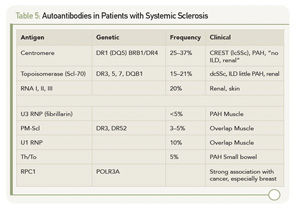Since the original description of anti-CCP antibodies,35,36 multiple studies have established the clinical utility of measuring these anticitrulline autoantibodies via commercial assays (anti-CCP) as a biomarker in RA.37 In addition to displaying a pooled sensitivity of 67% and specificity of 95% for the diagnosis of RA,38 it is now established that anti-CCP autoreactivity is prognostic for disease severity, radiographic erosions and the early recognition of RA.37,39 Rather than supplanting measurement of RF, the utility of anti-CCP has been demonstrated both by itself and in combination with measurement of serum RF. The consensus that has emerged from these studies is that, although anti-CCP and RF are frequently overlapping in their presence and prognostic significance, they are also independently informative in a significant subset of patients. The differences between subsets of RA patients with distinct autoantibody profiles remains poorly understood.
In addition to performance of these antibodies as a biomarker in the clinical setting, recent evidence suggests a pathogenic association between anticitrulline autoantibodies (measured by the anti-CCP test) and RA.40 Retrospective studies in multiple cohorts have demonstrated that measurable levels of anti-CCP autoantibodies frequently precede development of clinical arthritis with evidence for an increase in frequency and titers proximal to disease onset.41,42 At a population level, recent studies have shown that the presence of anti-CCP correlates with the presence of specific HLA-DR alleles with a particularly strong association with the “shared epitope” genes.43-46 At the level of basic mechanisms, citrullinated peptides from known autoantigens bind more avidly to MHC shared epitope than native peptides and are thereby capable of activating CD4+ T-lymphocytes. This property provides a plausible molecular basis for the genetic association seen in RA patients.47
An additional connection between smoking—a putative environmental trigger for RA—and anticitrulline autoantibodies provides further potential insight into mechanisms of disease evolution. It has long been appreciated that smoking confers an increased risk of RA.48-51 Although this finding has not been replicated in all cohorts, recent studies demonstrate that the increased risk conferred by tobacco exposure is present in the anti-CCP+ subset of subjects,37 and is associated with HLA‑DR alleles.45,46 Further, pulmonary lavage samples from smokers show citrullination of cellular proteins that is not present in nonsmoking subjects, providing a potential source of citrullinated antigens to induce autoantibody production. Moreover, citrulline posttranslational modification of tissue proteins occurs in diseased joints, and joint tissue citrullination levels are markedly elevated in the context of inflammation in both humans and experimental rodents.52-56

